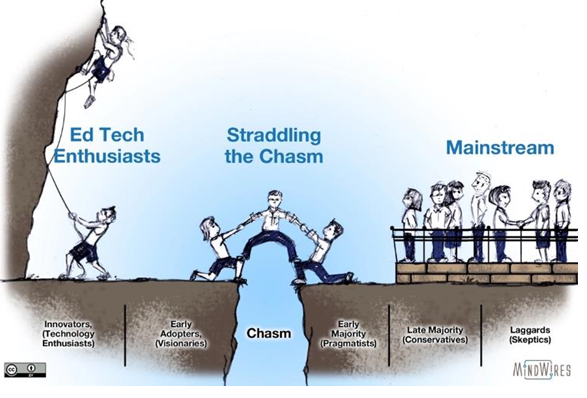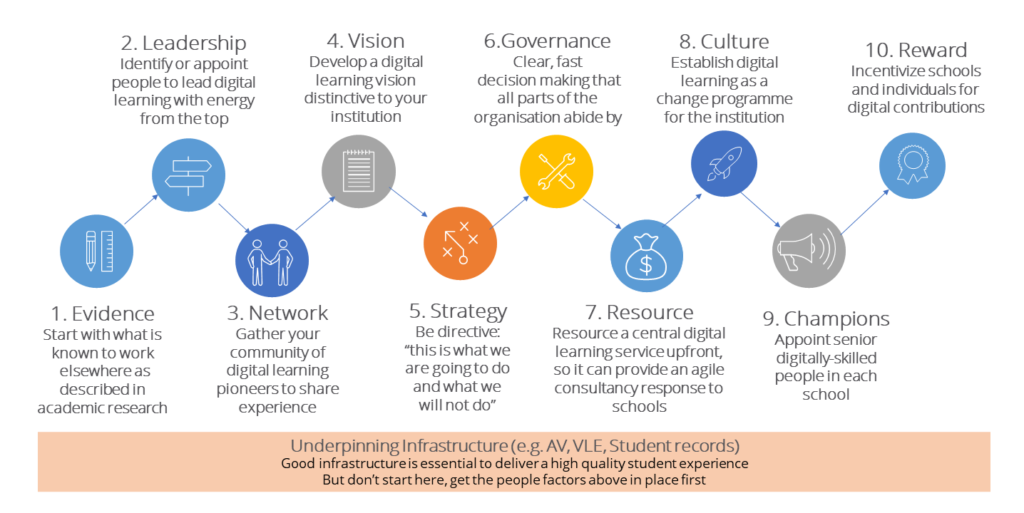
| Date | Author |
|---|---|
| 13th January 2022 | Claire Taylor and Nick Skelton |
The stakes are high when it comes to implementing the right digital learning strategy in higher education. An ambitious digital learning strategy is an opportunity to invent a new future, helping universities to grow, diversify and positively impact student satisfaction. But the wrong strategy or one that isn't properly implemented can leave an institution struggling to keep up with its competitors. Here, SUMS Managing Consultant Claire Taylor MBE and SUMS Associate Nick Skelton explore the elements of a successful digital learning strategy in higher education and share their model for successfully implementing your own digital learning strategy.
Creating a Digital Learning Strategy
An ambitious digital learning strategy in higher education institutions is an opportunity to invent a new future in which universities overcome barriers of time and distance. Universities will take advantage of greater flexibility and accessibility to better serve current students both on- and off-campus. They can excite potential students with open resources and pre-sessional activities. They should build robust lifelong relationships with alumni through ongoing learning and enrichment.
Digital learning will attract new students who previously found higher education too inflexible for their needs. This provides opportunities for universities to grow and diversify. Digital will become a central characteristic of the student experience across all universities, but it will be used in different ways. We at SUMS see three main areas of activity:
- Many institutions are committed to active blended learning for undergraduates, combining engaging, interactive tuition on campus with high-quality resources online.
- Some universities are launching part-time, fully online courses at the postgraduate level. These are valued by busy, mature students who appreciate the flexibility and accessibility available online.
- Other institutions are diversifying into new markets, offering online short courses in Continuing Professional Development.
These areas can be complementary. Once digital resources have been prepared, they can be adapted and reused for different purposes. This helps offset the investment required to prepare high-quality learning material.
Developing a digital learning strategy needs dialogue, debate and contributions from staff and students. The digital learning strategy must be an integral part of the wider strategy. It should draw on the institution’s existing distinctiveness in learning and teaching. Attempting to reinvent the institution and become something it’s not, is unlikely to be successful. Instead, understand your institution’s existing strengths and think about how you can use digital technology to better deliver your purpose.
Implementing a Digital Learning Strategy
The most difficult part of digital learning is not knowing what to do, but understanding how to achieve it. There is a strong history of digital learning over the last 25 years and good research evidence for what practices are effective. However, this history is littered with initiatives that came to little. Developments have often been pioneered by enthusiastic innovators but failed to make it over the chasm to adoption by other colleagues. The difficult part of digital learning is making it business-as-usual activity that is institution-wide.
Image 1: Stradling the Chasm by Phil Hill (Mindwires) is licensed under CC-BY 4.0
To achieve mainstream adoption, we need to think about creating and implementing a digital learning strategy in higher education quite differently. Digital learning should be an intentional process of transforming the institution. We need to focus on the change management process; digital learning teams working in partnership with staff and students to achieve change.
Implementing successful change requires an agile approach, designing, prototyping, and getting developments into service in months, not years. It requires academic staff and professional staff to appreciate others’ expertise and work in ever-closer partnership. It needs commitment to a whole-institution approach that delivers a joined-up student experience.
The Covid-19 pandemic accelerated change. All academics had to learn, experiment and develop their approaches to online teaching; students had to engage in online learning communities; and educational developers were in huge demand. Institutions can take advantage of that acceleration. The emergency pivot to remote learning, enforced by the pandemic, is very different to a carefully planned, high-quality digital approach. But the pandemic has changed student expectations and increased the confidence of staff in their use of technology. Now that the early rush is over, universities can take a more considered approach.
Working with several of our members and reaching out across the global HE community, SUMS has put together the following model for successfully implementing your digital learning strategy. It envisions implementation as a transformational change model rather than a transactional translation of content.
Image 2: SUMS Model for Successfully Implementing Your Digital Learning Strategy in Higher Education
- Evidence – Start with research evidence. This evidence base ensures that the techniques you identify are effective and also increases credibility with academic colleagues.
- Leadership – Identify leadership to lead the change visibly and enthusiastically. You will need someone to communicate, to negotiate with stakeholders and to own the benefits.
- Network – Gather a network of existing digital learning pioneers. Bring them together to learn from each other and energise the change.
- Vision – Develop a vision for digital learning which is distinctive to your own university and your own students – something that builds on what you do best.
- Strategy – Strategy is about saying what you will do and what you will not do. Once the vision is in place, be directive about what areas you will and won’t tackle.
- Governance – You need clarity over who makes which decisions, so people are empowered in their roles. Decisions that require group input still need to be made quickly.
- Culture – Create a culture where the digital learning unit is seen as a strategic change unit, working to improve whole programmes, schools and the institution.
- Champions – Identify or appoint digital champions within each academic school – respected figures who can demonstrate good digital practice in the discipline area.
- Resource – Provide appropriate resources for central digital learning functions, so that they can provide an agile response to demands from schools.
- Incentives – Create a financial model that provides appropriate incentives for schools, retaining a portion of additional income earned. Provide non-financial incentives for individuals, such as recognition of digital learning in time allocation models.
Financial Models for an Effective Digital Learning Strategy
The financial model for digital learning strategy in higher education should enable investment, incentivise growth and reward quality. Here are a few of the key takeaways:
- Invest upfront in a central digital learning function that provides internal consultancy to academic units through partnership working, free at the point of use.
- Split additional fee income between academic units and the institution. Allow academic units to retain a proportion of additional income from new digital learning programmes to incentivise growth and innovation. Ensure income is returned to the centre to support e-books, student study skills support and the other professional services students require.
- Incentivise individual academic staff to produce digital learning materials by reflecting this in workload models and reward criteria. Adopt policies that ensure that both the institution and the individual staff member can reuse resources; or share the benefits more widely through releasing material as open educational resources.
Barriers to Change
Of course, there are always obstacles along the path to success. We have identified some of the challenges that universities will need to address along the change journey, the most important of which are tools, structures, and policies.
Tools: Students can struggle to navigate digital systems, reducing engagement and attendance. Provide a personalised digital timetable for each student, with hyperlinks to online events, to help students get to the right digital place at the right time. The explosion of digital tools requires students to navigate through a maze of repeated logins. Provide a single entrance to the digital student journey through a portal, most likely the VLE. Use single sign-on to reduce cognitive load and smooth over points at which the experience may break and students are at risk of dropping out. Think of your digital learning tools as an overall ecosystem; when evaluating a new tool consider if there is a genuine niche for it in the ecosystem, or if the features it offers are outweighed by the frustration of yet another login.
Structures: Digital offers an opportunity to rethink delivery, freed from some of the constraints imposed by physical space and a rigid timetable. Students certainly value increased flexibility. It is common for online postgraduate programmes to have multiple start dates per year, and this certainly increases enrolment. But universities have embedded assumptions within their data models such as a single annual programme start date, two teaching periods and fixed assessment points. Consider whether new delivery methods such as multiple start dates are supported within your existing student data model. Programmes that deviate from the standard model will increase confusion and require registry staff to implement laborious manual workarounds, so manage the flexibility to reduce the impact. For example, all online programmes should pick from a small set of start dates, rather than different schools picking different start dates without coordination.
Policies: Staff and students may have many concerns about the adoption of digital learning. We have found concerns the following concerns when it comes to implementing an effective digital learning strategy in higher education:
- Security and privacy of data
- Copyright, ownership and use of educational materials
- Academic integrity of the educational process (particularly examination and assessment).
To combat these, we suggest a suite of policy decisions to allay these fears: an Open Educational Resources Policy, a policy for the reuse of learning materials, a lecture recording policy, an online assessment policy and so forth.
And Lastly, How Will We Know if We Get There?
As with most transformational change programmes, there is no single destination for digital learning. Technology is evolving ever more quickly and tomorrow’s students will have greater expectations. Universities should set qualitative and quantitative objectives, linked to the delivery of their overall strategic objectives. Introduce exemplar digital programmes that illustrate what is possible and inspire change through demonstrating success. Combine this with baseline standards for digital delivery that all programmes should meet. Think about your staff and students. Start from the student point of view: how can this initiative benefit students? Then understand the cultural factors necessary to support staff through the transformational change.
SUMS draws upon the expertise of leading practitioners within our member universities and shares what works for the benefit of others across the HE sector. We are working with universities across the UK to review, develop and implement effective digital learning strategies. If you would like to know more, access our bank of case studies or discuss how we can help you to transform your institution’s approach to digital learning, please do get in touch with Claire at s.c.taylor@reading.ac.uk
© 2022. This work is licensed under a CC BY NC ND license.










